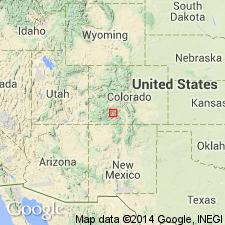
- Usage in publication:
-
- Snowshoe Mountain Quartz Latite*
- Modifications:
-
- Named
- Dominant lithology:
-
- Quartz latite
- AAPG geologic province:
-
- San Juan Mountains province
Summary:
Named for exposures on Snowshoe Mountain, Mineral Co, CO in the San Juan Mountain province, its type area. Consists entirely of crystal-rich ash-flow mostly densely welded tuff. Is drab and crystal rich. Consists on an average of half phenocrysts which are predominately plagioclase, but include in decreasing abundance, biotite, clinopyroxene, hornblende, quartz, sanidine, and magnetite. Is at least 4,000 ft thick and may, perhaps, be 6,000 ft thick. Is restricted to the Creede caldera. Assigned to the middle or late Tertiary, younger than the Huerto Formation or the Nelson Mountain Quartz Latite, and older than the Fisher Quartz Latite or the Creede Formation.
Source: GNU records (USGS DDS-6; Denver GNULEX).
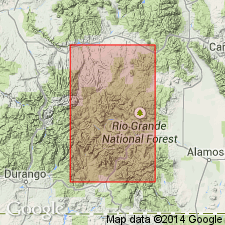
- Usage in publication:
-
- Snowshoe Mountain Quartz Latite*
- Modifications:
-
- Age modified
- AAPG geologic province:
-
- San Juan Mountains province
- San Luis basin
Summary:
Snowshoe Mountain Quartz Latite. Age changed from middle or late Tertiary --to-- Oligocene. (Adopted by the USGS.) [On p. D49 (table 1) shown older than Fisher Quartz Latite (26.4 Ma) and younger than informal tuff of Fish Canyon (27.2 Ma).]
Source: Publication; Changes in stratigraphic nomenclature, 1968 (USGS Bull. 1294-A, p. A17).
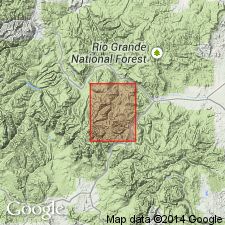
- Usage in publication:
-
- Snowshoe Mountain Tuff*
- Modifications:
-
- Redescribed
- Dominant lithology:
-
- Tuff
- AAPG geologic province:
-
- San Juan Mountains province
Summary:
Redescribed from Snowshoe Mountain Quartz Latite to Snowshoe Mountain Tuff. Described as a biotite-pyroxene quartz latitic ash-flow tuff containing 35-60 percent phenocrysts. Is the youngest ash-flow in the quad which lies in the San Juan Mountain province. Erupted from the Creede caldera. More than 1.3 km and perhaps more than 2 km deposited. Only a few of the scattered remnants have survived erosion. Two of these are capped by younger basalt. Assigned an Oligocene age.
Source: GNU records (USGS DDS-6; Denver GNULEX).
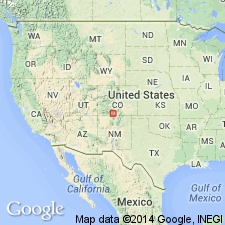
- Usage in publication:
-
- Snowshoe Mountain Tuff*
- Modifications:
-
- Overview
- AAPG geologic province:
-
- San Luis basin
- San Juan Mountains province
Summary:
Is the youngest ash-flow sheet in the central and eastern San Juan field. Erupted from the Creede caldera about 26.4 m.y. ago. Accumulated to at least 1,000 m thick within the caldera as a result of subsidence which was concurrent with eruption. Is weakly welded; only a few patches left. Rests on Wason Park Tuff except where it wedges between rocks of the Los Pinos Formation. Detailed lithologic description. Has normal remanent magnetic polarity. Known to occur in the San Luis basin and San Juan Mountain province, although areal extent not discussed in report.
Source: GNU records (USGS DDS-6; Denver GNULEX).
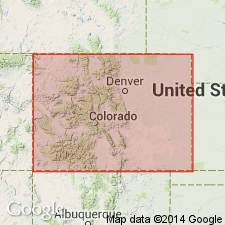
- Usage in publication:
-
- Snowshoe Mountain Tuff*
- Modifications:
-
- Areal extent
- AAPG geologic province:
-
- San Juan Mountains province
- San Luis basin
Summary:
Snowshoe Mountain Tuff. Areal extent of Snowshoe Mountain in southwestern Colorado shown on distribution map; remnants present in Rio Grande and Saguache Counties (San Luis basin), and Mineral County (San Juan Mountain province). Derived from the Creede caldera (the youngest caldera in the central San Juan caldera complex). Had an estimated volume of more than 500 cubic km. Age is more than 26.5(?) m.y.
Source: Modified from GNU records (USGS DDS-6; Denver GNULEX).
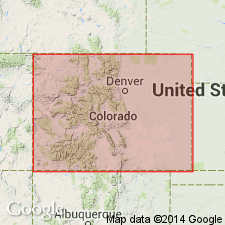
- Usage in publication:
-
- Snowshoe Mountain Tuff*
- Modifications:
-
- Geochronologic dating
- Overview
- AAPG geologic province:
-
- San Juan Mountains province
Summary:
Is ash-flow sheet questionably associated with Creede caldera in central San Juan Mountains of CO, San Juan Mountain province. High-resolution 40/39 Ar geochronology (unpublished data, M. Lanphere, USGS) yields age of 26.6 Ma [late Oligocene].
Source: GNU records (USGS DDS-6; Denver GNULEX).
For more information, please contact Nancy Stamm, Geologic Names Committee Secretary.
Asterisk (*) indicates published by U.S. Geological Survey authors.
"No current usage" (†) implies that a name has been abandoned or has fallen into disuse. Former usage and, if known, replacement name given in parentheses ( ).
Slash (/) indicates name conflicts with nomenclatural guidelines (CSN, 1933; ACSN, 1961, 1970; NACSN, 1983, 2005, 2021). May be explained within brackets ([ ]).

